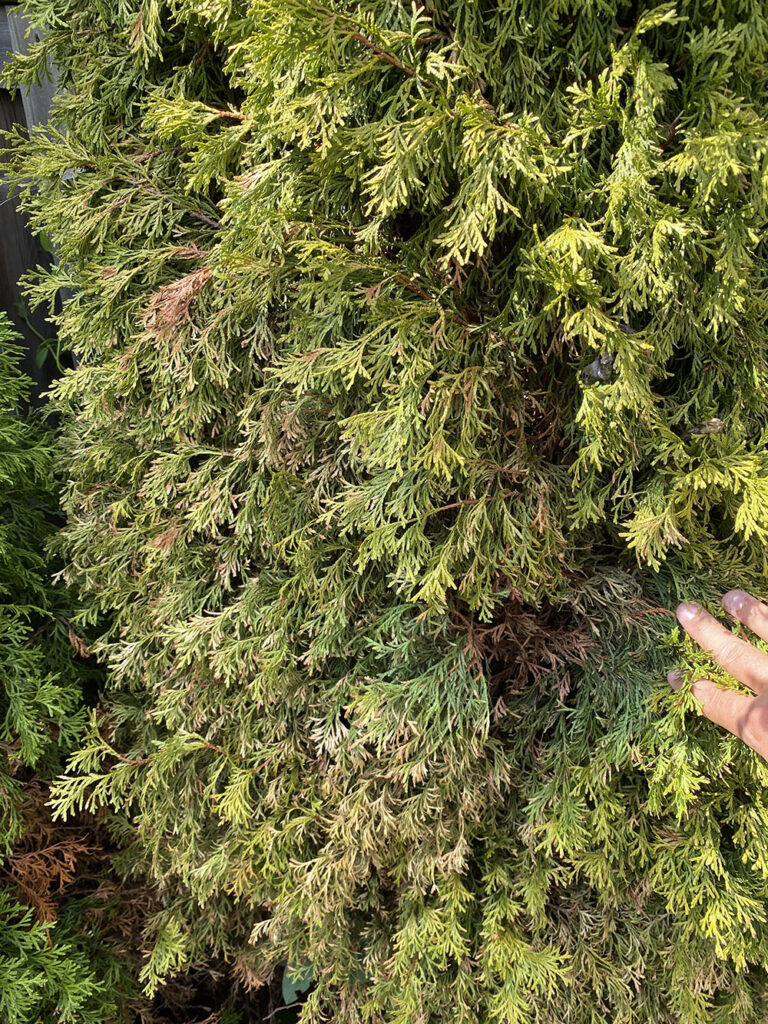
Hi I have mature cedars which are suddenly filled with Spider Web and Moth, I keep removing the spider webs and they keep coming back.
I usually Fertilize them with 30-10-10 from April to Sep but I noticed this year that few trees turned Brown/black so I stopped fertilizing back in Jun. Now the trees are turning yellow and one of them is in bad shape as seen in the pics.
someone came to see them and advised that it might be Verticillium Wilt and needs fertilizer and Insecticide
Can you please help
The advice that you received sounds appropriate if you have a severe infestation of the web spinning Spider Mites. Spider Mite can be controlled with insecticidal soap sprayed on the foliage in the fall. This helps to prevent the mites overwintering on your trees. This is a contact insecticide, so if it doesn’t have contact with the tiny mites at the time of spraying, they are not affected and survive. It is difficult to coat the foliage thoroughly and evenly with a single treatment of store bought insecticide spray. Some other plants in your garden may be sensitive to this spray. It is a good job for an arborist – who is better equipped to target the mites. The arborist can also assess your trees and may recommend giving your trees a deep root fertilizer treatment in the fall to improve their health.
If calling an arborist isn’t an option, then it is possible to significantly reduce the population of mites by spraying your trees with a strong spray of water. This is best done in the morning. Avoid spraying the foliage later in the day, as the leaves may not dry out adequately -which can make your weakened plants susceptible to disease. The hose spray will dislodge the mites fairly easily, but will not reach all of them in one treatment. Repeat this water spray method at least once a week during the warmer weather.
Cedar Leaf Miner, Argyresthia canadensis, is a possible culprit for your leaf yellowing- although it may also be the natural ‘flagging’ that occur on cedars. Cedar Leaf Miner eggs are laid mid to late summer. The caterpillar eat, or ‘mine’ the leaves -which turn yellow, then eventually brown. The caterpillars overwinter inside the cedar leaves in their larval stage, then emerge as White moths in June and July- which you have witnessed.
Insecticidal sprays can be used to kill the emerging moths in spring, and caterpillars in late summer-early fall. If the caterpillars are already inside the leaves, arborists recommend systemic insecticide implants that are injected into the trunk. There are also natural controls that have moderate success in less severe infestations. Squashing the caterpillars while they are feeding on the outside of the leaves can greatly reduce numbers. Parasitic wasps lay their eggs into the overwintering larvae and can also reduce population sizes.
Many cedars sold in Toronto are native to the cooler, wetter climate in British Columbia. Drought stressed cedars are more susceptible to insect infestations and fungal diseases. If you can improve the health of your trees, they will be less likely to have severe infestations in the future. Inadequate or too much water, mulch or fertilizer are the most common plant stressors.
During Toronto’s hot summer periods it is important to give your mature cedars a deep watering at least once a week. This means watering your trees until the top 6-9 inches of soil is moist. A sprinkler on low for about 15 minutes is a good start. Wait 30 minutes after watering and dig a small hole next to your trees. Check to see how deep the water has soaked in. If it is less than 6 inches, repeat the watering. Different soil conditions require different watering times, so it is useful for you to know how long to leave the sprinkler on to adequately hydrate your trees. It can also save water, if it is a shorter time than you had anticipated.
Check the mulch levels around your trees, and keep it an inch or two from the trunk to prevent ‘collar rot’ of the trunk. Three inch deep, good quality mulch will help to keep your soil moist and slow down the evaporation of soil moisture in between waterings. Mulch conditions soil as it breaks down and helps to improve drainage -which cedars prefer.
Over fertilizing your trees can cause stress and foliage die back. Fertilizers can contain high levels of salts that draw moisture out of the roots, and build up in the soil if applied too frequently. Fertilize your trees once a year, in early spring, with an organic based evergreen tree fertilizer. Aim for a fertilizer with less nitrogen than your current blend, like 20, for a ratio of around 20-10-10.
If your trees are well mulched, watered and fertilized they can recover from both mite and leaf miner infestations.

